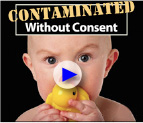
All of us are exposed to toxic chemicals on a daily basis from our air, water and the products all around us in our homes. Shower curtains, water bottles, baby bottles, toys, shampoo, cosmetics, couch cushions, computers and hundreds of other common products contain hazardous chemicals that leach out of the products and into our bodies. Communities where chemicals are made and disposed of -- which are often communities of color or low-income communities -- are disproportionately impacted by cancer and other diseases. By working to eliminate toxic chemicals in products, we are working to protect the health of everyone and helping to reduce the burden of toxic chemical exposure in communities around the world.
Our Body Burden of Toxic Chemicals
Every infant born today carries toxc chemicals inside his or her body, passed from mother to child during pregnancy. Even in extremely tiny doses, many chemicals can derail the delicate systems that control our development, health and reproduction. Fetuses in the womb and children throughout their development are especially vulnerable, even through puberty.
Scientists at the Centers for Disease Control and Prevention measure hundreds of hazardous chemicals in the bodies of Americans every few years. In the most recent study, CDC tested for 212 chemicals and found most of them inside people, including young children and women of childbearing age. Even the breakdown products of DDT — a toxic pesticide banned in 1972 — have been found in 99% of Americans tested.
Chemicals, Cancer and Health Risks
Respected scientists are sounding the alarm on this growing public health crisis. In 2009, the President’s Cancer Panel reported that "the true burden of environmentally induced cancer has been grossly underestimated,"and urged the President to “most strongly use the power of your office to remove the carcinogens and other toxins from our food, water, and air that needlessly increase health care costs, cripple our Nation’s productivity, and devastate American lives.” Read the President's Cancer Panel report.
Chemicals can trigger cancer in a variety of ways, including disrupting hormones, damaging DNA, inflaming tissues and turning genes on or off. More than 40% of Americans will battle some form of cancer in their lifetimes — obviously, there is an urgent need to reduce carcinogens in our environment and in our homes.
Many chronic diseases and syndromes have been linked in scientific studies to toxic chemicals in consumer products, including birth defects, decreased fertility, asthma, learning and developmental disabilities, prostate, kidney and other cancers, thyroid disorders, hearing loss and Parkinson’s disease. Track the latest news on science at Environmental Health News.
Environmental Justice for All
People of color are disproportionately impacted by toxic chemicals. For example, personal care products marketed to people of color, such as hair straighteners and skin lighteners, are some of the most toxic. Lower income people may be more likely to have older furniture, with disintegrating foam that further spreads toxic flame retardant chemicals. Those with fewer resources may depend more on canned food, thus increasing their exposure to BPA. Additionally, hazardous chemicals in consumer products begin in factories where workers and surrounding low income and communities of color suffer ongoing exposure to toxic emissions from manufacturing and eventual disposal of these products.
Reducing toxic chemicals and shifting to safer alternatives is urgent for health, justice and the long-term sustainability of our economy. Our Five Essential Practices for Retailers, Brand Owners and Suppliers provide guidance to what retailers, brand owners and suppliers should do that is supported by leading market campaigns. On this website, the Workgroup for Safe Markets has compiled the best tools and resources to help consumers, businesses, schools and hospitals avoid toxic chemicals and shift the market to safer alternatives.




